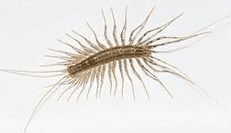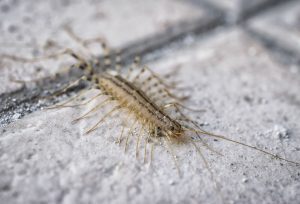Identification and Life Cycle
There are more than 2,000 species of centipede, but the more common one is the House Centipede, Scutigera coleoptrata. They prefer to live in cool, damp places outdoors, but are commonly seen indoors in basements, bathrooms and occasionally in bedroom areas.
They are approximately 1 1/2 – inches long, and are brown to grayish-yellow in color with three dark stripes on top. It has a flattened head with well-developed, faceted eyes, a pair of antennae, and 15 pairs of slender legs that are encircled by dark and white bands. It features a unique pincer-like appendage found behind the head used to capture and inject venom to kill or paralyze its prey.
In the spring, they will lay an average of 50 to 100 eggs. As with many arthropods, the larvae looks like a miniature version of the adult, but with only 4 pairs of legs, not 15. They develop a new pair of legs with the first molting stage, and two additional pairs for each of the next five moltings. They have a lifespan from 3 to 7 years, depending on their environment. It does not survive winters, but will reproduce in heated structures.





Comments are closed.